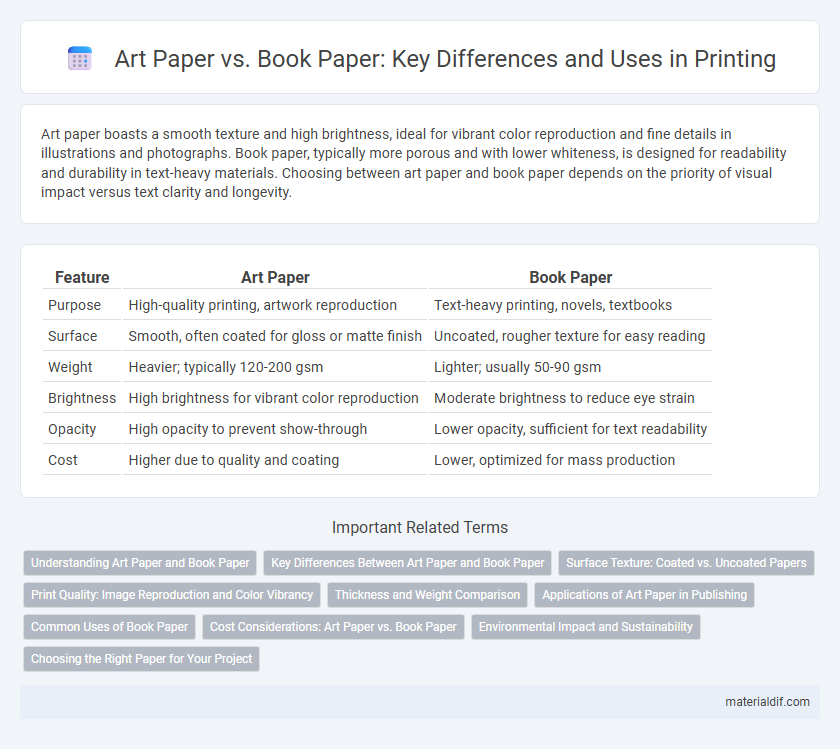Art paper boasts a smooth texture and high brightness, ideal for vibrant color reproduction and fine details in illustrations and photographs. Book paper, typically more porous and with lower whiteness, is designed for readability and durability in text-heavy materials. Choosing between art paper and book paper depends on the priority of visual impact versus text clarity and longevity.
Table of Comparison
| Feature | Art Paper | Book Paper |
|---|---|---|
| Purpose | High-quality printing, artwork reproduction | Text-heavy printing, novels, textbooks |
| Surface | Smooth, often coated for gloss or matte finish | Uncoated, rougher texture for easy reading |
| Weight | Heavier; typically 120-200 gsm | Lighter; usually 50-90 gsm |
| Brightness | High brightness for vibrant color reproduction | Moderate brightness to reduce eye strain |
| Opacity | High opacity to prevent show-through | Lower opacity, sufficient for text readability |
| Cost | Higher due to quality and coating | Lower, optimized for mass production |
Understanding Art Paper and Book Paper
Art paper features a smoother finish and higher brightness, enhancing color vibrancy and image detail, making it ideal for high-quality prints and artwork reproduction. Book paper is typically more porous and less bright, designed for readability and reduced glare in text-heavy publications, often featuring a matte or uncoated surface to prevent ink bleed. Understanding these characteristics helps in selecting the appropriate paper based on the intended use, balancing visual appeal and practical readability.
Key Differences Between Art Paper and Book Paper
Art paper features a smooth, high-quality surface with a glossy or matte finish designed for vibrant color reproduction and fine detail, making it ideal for brochures, posters, and art prints. Book paper is typically lighter, more absorbent, and designed for readability, featuring a matte finish to reduce glare and enhance text clarity in novels and textbooks. The weight and opacity of art paper are generally higher than book paper, preventing ink bleed-through and supporting complex images, while book paper prioritizes durability and cost-effectiveness for mass production.
Surface Texture: Coated vs. Uncoated Papers
Art paper typically features a coated surface that enhances color vibrancy and sharpness, making it ideal for high-quality images and fine art reproductions. Book paper often uses an uncoated texture, providing a matte finish that reduces glare and offers a more tactile feel suited for comfortable long-form reading. The choice between coated and uncoated surfaces directly impacts the visual appeal and usability of printed materials.
Print Quality: Image Reproduction and Color Vibrancy
Art paper offers superior print quality with enhanced image reproduction and vibrant color accuracy, making it ideal for high-resolution artwork and photography. Book paper typically prioritizes readability and durability over color vibrancy, resulting in less vivid images and muted tones. The surface texture and coating of art paper facilitate sharper details and richer colors compared to the matte or lightly coated finish of book paper.
Thickness and Weight Comparison
Art paper typically exhibits a higher thickness and weight, often ranging from 200 to 300 gsm, providing sturdiness ideal for painting and high-quality prints. Book paper generally has a lighter weight between 70 and 120 gsm, designed for ease of handling and cost efficiency in large volumes. Thickness in art paper enhances texture and durability, while book paper prioritizes thinness to maximize page count and reduce bulk.
Applications of Art Paper in Publishing
Art paper, renowned for its high-quality finish and vibrant color reproduction, is widely used in publishing for luxury magazines, art books, and promotional brochures to enhance visual appeal and detail. Its smooth surface and heavier weight make it ideal for showcasing photography, illustrations, and graphic design with superior sharpness and gloss. Unlike standard book paper, art paper's durability and aesthetic qualities cater specifically to premium publications where visual impact drives reader engagement.
Common Uses of Book Paper
Book paper is primarily used for publishing novels, textbooks, and reference materials due to its durability and readability. It features a smooth finish and optimal weight that supports extensive printing without bleeding or smudging. This paper type is favored for long-form reading where clarity and consistency in print quality are essential.
Cost Considerations: Art Paper vs. Book Paper
Art paper typically costs more than book paper due to its higher quality, specialized coatings, and texture designed for vibrant image reproduction. Book paper is generally more affordable, optimized for bulk printing and readability rather than visual impact, making it ideal for large volume publications. The cost differential heavily influences printing budgets, especially in projects balancing visual appeal with cost efficiency.
Environmental Impact and Sustainability
Art paper typically involves higher-quality fibers and coatings, resulting in increased resource use and environmental impact compared to book paper, which is often made from recycled materials or sustainably sourced pulp to minimize ecological footprints. Book paper production prioritizes lower energy consumption and reduced chemical treatments, enhancing sustainability by facilitating recycling and decreasing emissions. Sustainable practices in the paper industry favor book paper for eco-friendly publishing, while art paper's demand for premium aesthetics challenges environmental goals due to its intensive manufacturing processes.
Choosing the Right Paper for Your Project
Art paper offers a textured surface ideal for high-quality prints, paintings, and detailed illustrations, enhancing color vibrancy and detail. Book paper is typically smoother, lighter, and more economical, designed for durability and readability in mass-produced texts. Choosing the right paper depends on the project's purpose, desired finish, and budget constraints to achieve optimal presentation and longevity.
Art paper vs Book paper Infographic

 materialdif.com
materialdif.com